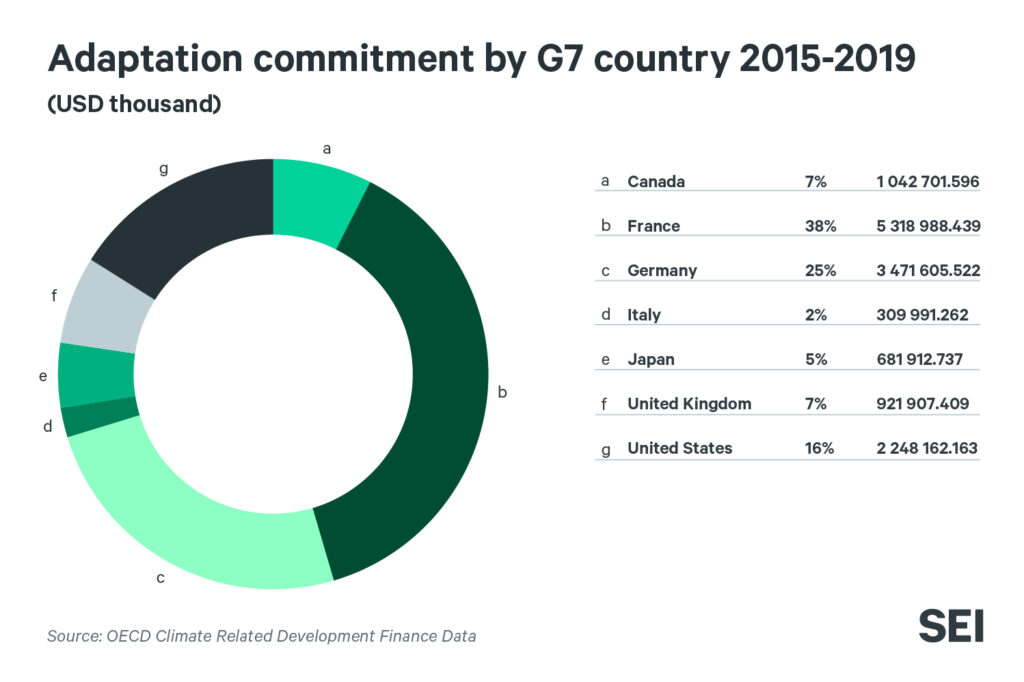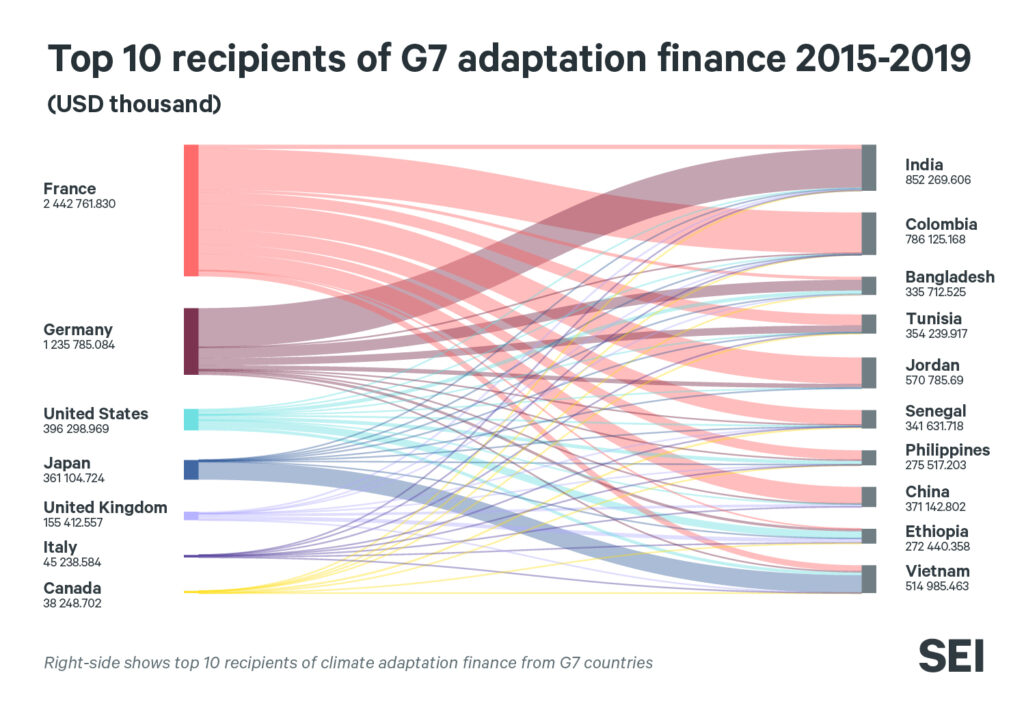As leaders from the G7 group of wealthy nations meet in the UK, the question remains as to whether they will heed calls from the UN Secretary General to double climate finance pledges to 2025. While an increase in climate finance is seen as critical for a successful COP26, which objectives it goes to and the financing form it takes also matter.
Are rich countries doing enough to help poorer countries reduce emissions and adapt to climate change? That’s what the climate finance debate has focused on, including with regard to the G7. Organisation for Economic Co-operation and Development (OECD) data show that from 2017–2018, G7 countries contributed an average of US$27.2 billion in public financing. However, an analysis from the Overseas Development Institute (ODI) – accounted for countries’ gross national income, population and cumulative carbon dioxide emissions from 1990–2018 to determine their responsible fair share of financing – estimated that these countries should in fact contribute 77–88% of the US$100 billion target annually.
So far, G7 countries have collectively provided well below this target through bilateral and multilateral channels. Furthermore, on an individual level, most G7 countries have not contributed their fair share. France and Germany, who have contributed over 100% of their share according to the ODI report, are the exception.
Poor countries are in particular need of financial support to plan and implement measures to adapt to the impacts of climate change. However, only 8% of overall climate finance has gone towards adaptation so far, according to the UN Environment Programme Adaptation Gap report. The report estimates that developing countries need from US$140 billion–US$300 billion by 2030 to support adaptation. From 2015–2019, G7 countries donated nearly US$14 billion to adaptation finance, with Germany and France contributing over 60% of the share.

Total commitments for climate change adaptation from G7 countries.
However, least developed countries (LDCs) do not feature as the top recipients of G7 countries’ adaptation finance. Only three LDCs – Bangladesh, Senegal and Ethiopia – were among the top recipients from 2015–2019.

Climate adaptation finance flowing from G7 countries (left) to 10 top recipients (right).
Small Island Developing States (SIDS), many of which are also LDCs and particularly vulnerable to the impacts of climate change, are not among the priority recipients of public G7 adaptation funds at all. In fact, they receive fewer funds from the G7 than all the lower- and upper middle-income countries combined.

Recipients of G7 adaptation finance according to income groups.
Amount and financing objectives aside, power relations are another critical aspect of climate finance. Looking in greater detail at the types of finance instruments used by G7 countries for funding climate action helps to understand these power relations.
The anti-poverty organization Oxfam estimates that from 2017–2018, only about 20% of overall public climate finance was provided through grants. Debt instruments constituted the majority of financing forms. OECD data show that of the adaptation finance committed from 2015–2019, 54% was delivered through debt instruments and 46% through grants.
For donors, grants provide power that is limited in space and time, whereas the power wielded by debt and equity measures is extended and increased through time. Equity financing, which does not necessarily have a time limit, gives the lender ownership of a stake in a climate project, affording them, for example, a share in decision-making.
As a result, by entering into equity commitments, LDCs may progressively relinquish power in exchange for climate finance, over an increasingly lengthy time scale. Through the back door of climate action, a new form of colonialism may develop.
For developing countries, particularly LDCs and SIDS, debt repayment steers resources away from addressing critical structural development issues, such as poverty, education, health and food security. The inability to tackle these critical development issues further exacerbates people’s vulnerability to climate change. Similarly, equity instruments constrain the ability of countries to make autonomous decisions on development pathways, and often force governments to align their priorities with those of funders, even though they may not correspond to the needs of local communities.
The irony here cannot be overlooked: for SIDS and LDCs, some of which are the most underdeveloped and climate vulnerable, climate financing may prevent significant advancements in climate action.

Rundown buildings in the capital city of Madagascar, Antananarivo. Photo: Kieran Stone / Getty Images.
Since the Covid-19 pandemic broke out, development aid from bilateral donors has decreased, including from the UK, now hosting the G7 summit and due to host the UN climate conference COP26 in November. Given this, there is a certain irony in the fact that the UK has made adaptation action, and increased adaptation finance, a key goal of COP26.
To demonstrate its own resilience to crises and its commitment to supporting climate actions in developing countries, the G7, under UK leadership, should start by increasing adaptation finance.
However, G7 nations must also scrutinize the use of debt and equity instruments in climate financing. Accountable and responsible climate financing is crucial in global efforts towards keeping global warming to “well below 2 degrees”, as committed to in the Paris Agreement.
When it is necessary to use climate financing instruments that impose greater debt burdens on developing countries, donors must do so prudently. It is also vital that embedded in these climate finance instruments are environmental and social safeguards, co-created with the local stakeholders and tailored to local contexts and communities.
Furthermore, the G7 can signal their support for these efforts towards accountable and responsible climate finance by agreeing, for instance, to a baseline percentage of grant contributions they would make. Parties under the UN Framework Convention on Climate Change can also contribute by pushing for accountability guidelines to monitor climate finance instruments.
In the run-up to COP26, the G7 has an opportunity to demonstrate unity and commitment towards climate change – it is up to them to seize it.
Design and development by Soapbox.